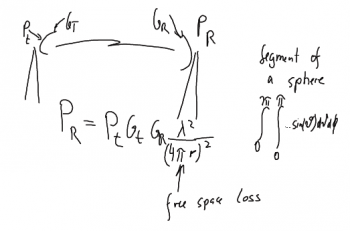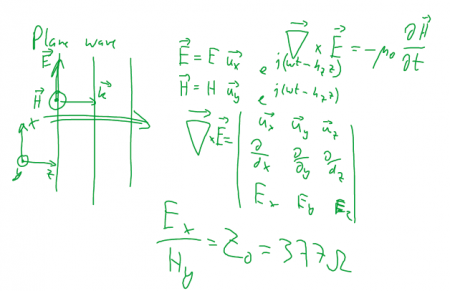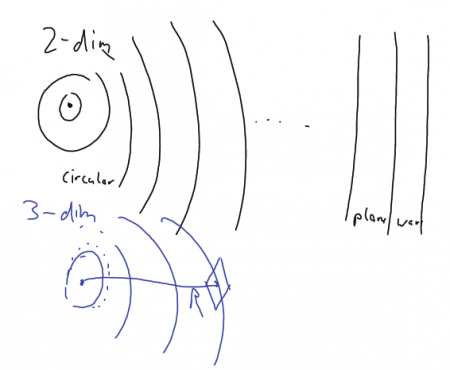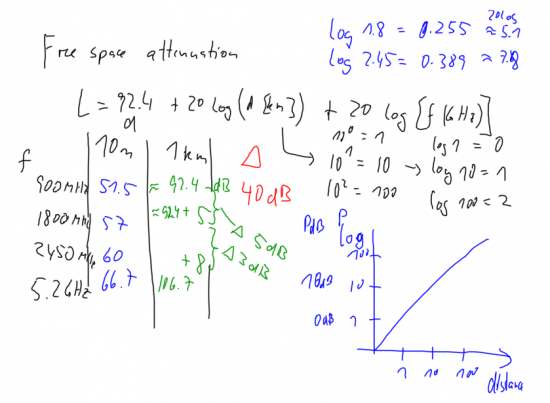Difference between revisions of "B1-Free Space Propagation"
From its-wiki.no
Josef.Noll (Talk | contribs) |
Josef.Noll (Talk | contribs) |
||
| Line 1: | Line 1: | ||
| − | =⌘ | + | ==⌘ Background: Wave Propagation == |
| − | + | ||
| − | + | ||
| − | + | ||
| − | + | ||
| − | + | ||
| − | + | ||
[[File:f3-8.png|450px|right|Calculation of a plane wave, proove that Z_0 = ... = E_x/H_y]] | [[File:f3-8.png|450px|right|Calculation of a plane wave, proove that Z_0 = ... = E_x/H_y]] | ||
| Line 12: | Line 6: | ||
[[File:f3-9.png|450px|right|Cylindrical, plane and spherical wave]] | [[File:f3-9.png|450px|right|Cylindrical, plane and spherical wave]] | ||
| + | =⌘ Task: Plane wave propagation = | ||
| + | <span style="color:#000B80">Assume a plane wave: <math>E_x, H_y</math>. Show that <math>\frac{E_x}{H_y}=Z_0 = \sqrt{\mu_0/\varepsilon_0}</math> | ||
| − | + | <span style="color:#000B80">What is the relation between a plane wave and an omnidirectional wave? | |
| − | <span style="color:#000B80"> | + | |
| − | |||
| − | |||
| − | |||
| − | |||
| − | |||
| − | |||
| − | |||
| − | |||
| − | |||
| − | |||
| − | |||
| − | |||
==⌘ Free space propagation == | ==⌘ Free space propagation == | ||
| Line 51: | Line 34: | ||
Calculation of free space attenuation. Note the increased free-space attenuation of approx 5 dB from 900 to 1800 Unik/MHz, and a further increase of 3 dB from 1800 (GSM 1800) to 2450 Unik/MHz (802.11b). Note also that increasing the distance by a factor of 10 will increase the power requirements by 20 dB. | Calculation of free space attenuation. Note the increased free-space attenuation of approx 5 dB from 900 to 1800 Unik/MHz, and a further increase of 3 dB from 1800 (GSM 1800) to 2450 Unik/MHz (802.11b). Note also that increasing the distance by a factor of 10 will increase the power requirements by 20 dB. | ||
| − | |||
| − | |||
| − | |||
| − | |||
Revision as of 08:00, 21 September 2014
| Wiki for ITS | ||||||
|---|---|---|---|---|---|---|
|
Contents
⌘ Background: Wave Propagation
⌘ Task: Plane wave propagation
Assume a plane wave: . Show that
What is the relation between a plane wave and an omnidirectional wave?
⌘ Free space propagation
develop propagation equation, see (http://www.antenna-theory.com/basics/friis.php)
- convert into dB
- provide examples for f = 10 MHz, 1 GHz, 100 GHz
- discuss influences on radiation pattern
Free space attenuation
⌘Comments

|
Free space propagation from a transmit (t) to a receive (r) station. |
Calculation of free space attenuation. Note the increased free-space attenuation of approx 5 dB from 900 to 1800 Unik/MHz, and a further increase of 3 dB from 1800 (GSM 1800) to 2450 Unik/MHz (802.11b). Note also that increasing the distance by a factor of 10 will increase the power requirements by 20 dB.


